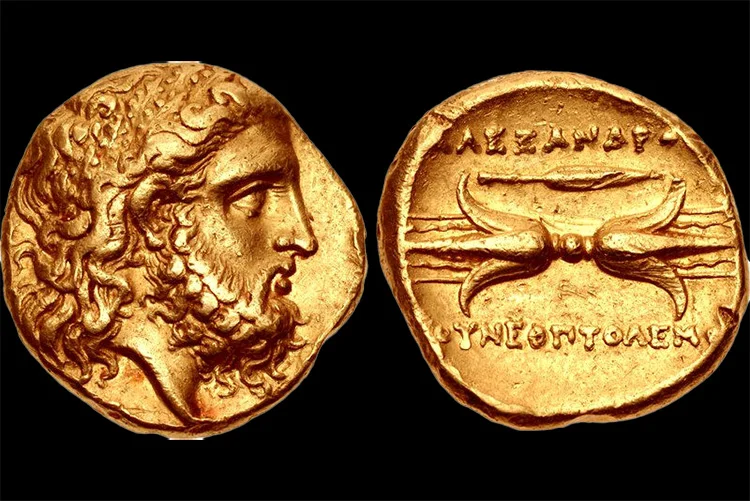

In the mid-4th century BC, King Philip II of Macedon waged a war against his north-western Greek neighbours, the Molossians, driving their king into exile in Athens in 343 BC. To safeguard his interests in this important region, Philip turned to a young royal Molossian who had been a hostage of his for the last seven years: Alexander of Molossia.
This ‘other’ Alexander had developed into a capable, Macedonian-style leader during his time as a hostage. Philip now entrusted him with the captured Molossian throne. Seeking to strengthen his western border, Philip endowed one more ‘gift’ to Alexander: three coastal cities in southern Epirus; Pandosia, Bucheta and Elatria.
Thanks to Philip, Alexander therefore found himself inheriting a kingdom stronger than it had ever been. No longer was Molossia simply an inland kingdom on an unstable frontier of the Greek world. Now, Alexander ruled a kingdom allied to a rapidly rising Greek power that also, for the first time, had a direct link to the Mediterranean Sea.
The possibility of conquest across the Ionian Sea in Italy and Sicily now appeared open to Alexander. Envisaging himself as the protégé to his mentor, Philip, he prepared his own great plans of conquest. He saw the west as his oyster. Yet before he could even dare to attempt such a formidable expedition, he needed allies. Fortunately, he knew exactly where to look.
Uniting the Tribes
At that time, the region of Epirus was fragmented between many smaller kingdoms. Molossia was just one of these. Two others controlled large amounts of this unstable territory: the kingdoms of Thesprotia and Chaonia.
If Alexander wanted to launch an ambitious campaign in the west then having an alliance with these two immediate neighbours was critical. Alexander believed that this may not be as improbable as others thought. Although each of these kingdoms treasured their own tribal identity, the Chaonians, Thesprotians and Molossians had also previously fought side by side, linked by a shared Epirote identity.
The Epirote Alliance

Coin from the reign of Alexander the Molossian. Leader of the Epirote Alliance . The figure depicted is Zeus, the patron God of the Oracle at Dodona
Image Credit: Classical Numismatic Group, Inc on Wikimedia Commons, CC BY-SA 3.0
By appealing to this sense of shared identity and tempting his neighbours with his intended, glorious campaign to the west, Alexander convinced the Chaonians and Thesprotians to join him. At Passaron an alliance was agreed; Alexander would be their leader. For the first time ever, Epirus was united and its borders secure; the constant worry and threat of barbarian raids from the North seemed a distant memory. Alexander’s preparation for his great conquest was taking shape.
Alexander made sure that the Epirotes would not regret selecting him as their commander. His time learning the art of war from formidable generals such as Philip, Parmenion and Cleitus in Macedonia had turned him into an ambitious, charismatic and, most of all, skilled young leader. All Alexander had to do now was prove himself to the Greek world. Gaining great success on an intrepid military campaign was therefore a must.
The Epirote army
However upon Alexander’s accession, the Epirote forces were disorganised, ill-disciplined and backward. Having suffered decades of raids from northern barbarians in the past, Epirus was very much the ‘left-behind’ region in the Greek World. And it showed.
There were no rich cities, adorned with jaw-dropping architecture or magnificent temples in that region. Instead, Epirus had remained sparsely populated, its military power hindered by its past lack of unity and austerity; no wonder they had been easy pickings for northern raiders.
Macedonia had similarly been regarded as backward before Philip. 20 years on from his accession, Macedon was quickly becoming supreme – its armies proving unstoppable to any that opposed it. If Philip could transform Macedonia, Alexander likely thought, then surely he could do the same with Epirus.
Gathering a large army from across a united Epirus, Alexander set about introducing his men to a new style of warfare – a style that soon became the mainstay of every powerful nation in the Eastern Mediterranean for the next 150 years.

The Macedonian phalanx, from “Cassell’s Illustrated Universal History” (1893).
Image Credit: British Library / Public Domain
The Macedonian Phalanx
From his time in Macedonia, Alexander had watched first-hand the creation of this radical new development in Greek warfare. He had already witnessed the deadly effectiveness of the Macedonian phalanx in battle and its critical role in Philip’s quick ascendancy to dominance in mainland Greece.
Alexander began arming his infantry with the iconic, twenty-foot-long sarissas. Equipped in such a fashion, his modernised Epirote soldiers were then arranged into large, deep, phalanx formations. His cavalry, too, Alexander also started to transform, turning them into the powerful shock arm of his new-look army.
Ready for war
Soon enough, Alexander had completely transformed the Epirote army. Before Alexander, it had been no greater than a rabble of crudely-armed levies. Now, having been trained in the image of Philip’s powerful Macedonians, Alexander had turned his soldiers into a force ready for war.
All Alexander wanted now was an opportunity; he yearned for the chance for a great conquest where he could show off his talent on the field of battle. He had set his eyes on the west for a long time, to Italy and the great riches that awaited him there. All that he required was a convincing pretext for waging war, but this would come soon enough.













